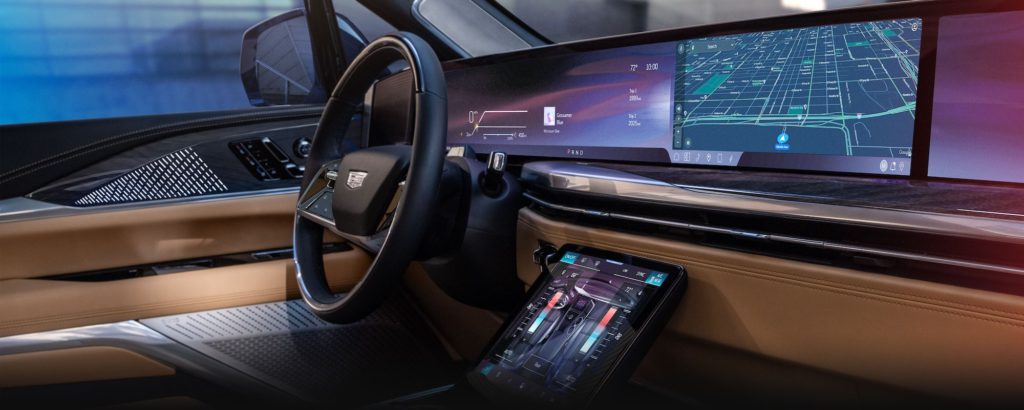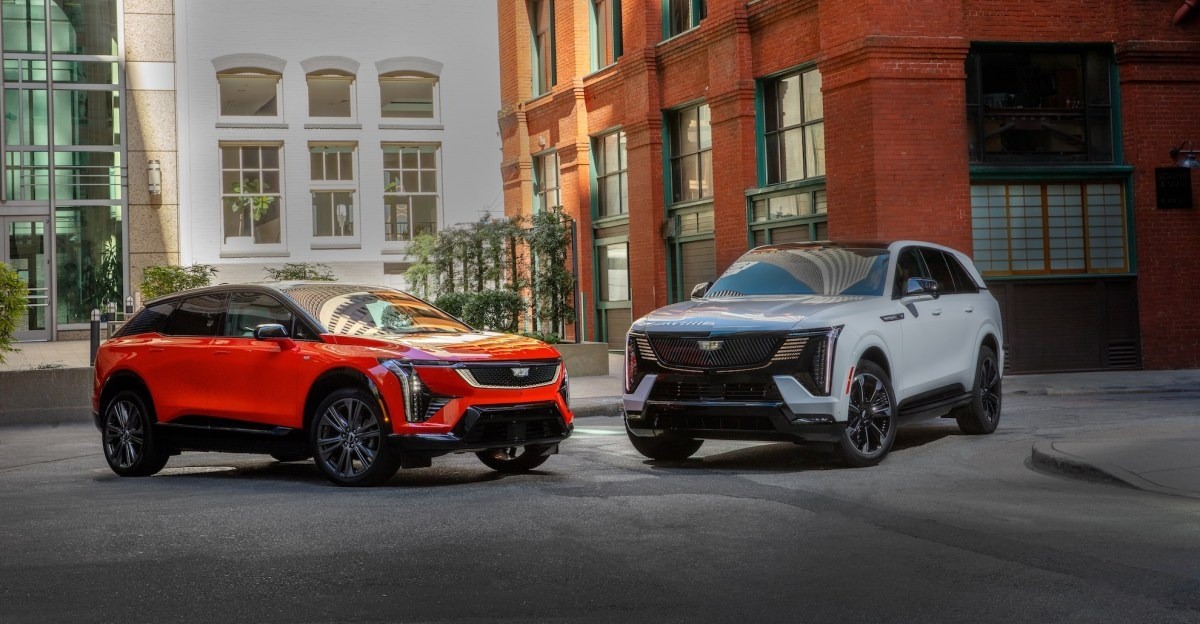Cadillac is making a bold statement in the electric vehicle market with its new IQ portfolio, repositioning the brand at the forefront of luxury and technology. This article explores how Cadillac has created two dramatically different approaches to electric luxury with the compact Optiq SUV and the flagship Escalade IQ. These vehicles represent Cadillac’s strategy to appeal to different customer demographics—”Young and Fun” versus “Old Money Luxe”—while elevating the brand’s technology offerings. Let’s examine the ten key aspects that define Cadillac’s new electric direction and how these two vehicles represent distinctly different visions of luxury mobility.
Performance Philosophy: Sporty vs. Stately

The Optiq and Escalade IQ embody fundamentally different approaches to performance. The compact Optiq, influenced by Cadillac’s Blackwing performance team, delivers an engaging driving experience with its 300 horsepower and 354 pound-feet of torque. Its “Passive Plus” tuned suspension keeps the vehicle flat through corners while remaining comfortable over rough pavement—making it genuinely entertaining on twisty roads. The author notes it “can handle broken pavement without getting upset” while providing sporty handling without complex electronics. Meanwhile, the Escalade IQ represents classic American luxury with its focus on comfortable cruising. Despite having more than double the power (700 horsepower and 785 pound-feet of torque in “Velocity Max” mode), this three-row electric behemoth uses that muscle primarily to overcome its substantial 9,000-pound weight. The Escalade prioritizes smooth, comfortable driving with features like rear-wheel steering to make its massive wheelbase more manageable in tight spaces.
Regenerative Braking: A New Driving Dimension

Electric vehicles introduce new driving dynamics, and regenerative braking represents one of the most significant changes from traditional internal combustion vehicles. The Optiq offers a customizable approach to this feature, allowing drivers to tailor their experience. You can disable regenerative braking entirely and rely on conventional mechanical brakes, set it to “normal” for light deceleration when lifting off the accelerator, or maximize it for stronger deceleration without touching the brake pedal. For enthusiasts, this adds “another level of skill” as the author describes—essentially “the gamification of driving.” The Optiq even includes a steering wheel paddle to engage additional regenerative braking on demand, providing precise control over deceleration. This variable approach to regenerative braking transforms the driving experience, adding a new dimension of control that engages drivers in a distinctly electric way.
SuperCruise: Hands-Free Driving Standard

Both vehicles come standard with Cadillac’s advanced SuperCruise system, which allows for hands-free, eyes-up driving on 750,000 miles of mapped highways across North America. This driver assistance system represents Cadillac’s commitment to advanced technology across its lineup, regardless of price point. SuperCruise can change lanes automatically to pass slower vehicles or when the driver activates the turn signal. The author notes impressive performance even in challenging conditions, observing that while testing the Escalade IQ “in rain and fog,” the system “had no problems reading lane markings through the mist” despite a brief hesitation when executing a lane change during a sweeping turn. By making this premium technology standard on both models, Cadillac signals that advanced driver assistance is now a core brand value rather than an expensive option.
Battery Strategy: Right-Sized vs. Maximum Range

Cadillac has taken distinctly different approaches to battery capacity and range for these two vehicles. The compact Optiq features an 85 kWh battery delivering 302 miles of range—a balanced capacity for its size and purpose. Its 400-volt architecture supports DC fast charging at 150 kW, providing approximately 79 miles of range in a 10-minute charge. In dramatic contrast, the Escalade IQ houses a massive 205 kWh battery pack that delivers an impressive 460 miles of range. Like the GMC Hummer EV, the Escalade IQ utilizes an architecture with two 400-volt battery packs that can work in series or parallel, enabling ultra-fast DC charging at up to 350 kW—enough to add 100 miles of range in just 10 minutes. Both vehicles support home charging with standard 11.5 kW onboard chargers (upgradable to 19.2 kW), providing approximately 36 miles of range per hour when charging at home. This tiered approach ensures each vehicle has appropriate range capabilities for its intended use case.
Interior Design Philosophy: Youthful vs. Sophisticated

The interiors of these two vehicles reflect their distinct target demographics. The Optiq embraces a younger, more progressive aesthetic with recycled materials, clean design lines, and innovative storage solutions. Its cabin represents contemporary luxury with an emphasis on sustainability and functional minimalism. In contrast, the Escalade IQ “appeals to an older, more sophisticated crowd” with its more traditional interpretation of luxury. Both interiors feature extensive digital displays—33 inches of screen space in the Optiq and an impressive 55 inches spanning the entire dashboard in the Escalade IQ. The larger SUV even includes a passenger screen that can play movies or browse the web without distracting the driver. These divergent interior approaches demonstrate Cadillac’s understanding that luxury means different things to different consumers, allowing the brand to appeal to multiple demographics while maintaining core brand values.
Audio Technology: Next-Generation Sound

Cadillac has made significant investments in audio technology, particularly in the Optiq. The compact SUV features a 19-speaker AKG Audio system with Dolby Atmos capability, creating an immersive three-dimensional sound experience. The author describes this system as “seriously kicking” with sounds that bounce “around the cabin in a way that delighted even my deficient left ear.” This spatial audio technology represents a new frontier in automotive sound systems, bringing studio-quality audio experiences to the vehicle environment. Interestingly, the more expensive Escalade IQ does not currently offer Dolby Atmos due to development timelines, though the feature is expected in 2026. The Escalade’s top trim does include a 38-speaker AKG sound system, emphasizing Cadillac’s commitment to premium audio across its lineup. This focus on advanced audio technology acknowledges that the auditory experience is increasingly important in the luxury segment.
Digital Integration: Google-First Approach

Both vehicles take a bold stance on digital integration by foregoing Apple CarPlay and Android Auto in favor of Google Built-in for maps and smartphone interaction. This approach represents a significant departure from industry trends, where compatibility with both major smartphone ecosystems has become nearly universal. The Google system offers some advantages, such as suggesting charging stations and estimating remaining range at the end of journeys. However, the author struggled with setting up Google Assistant to read text messages, requiring engineering assistance in the Escalade IQ and never successfully configuring it in the Optiq. This highlights the challenges of moving away from familiar smartphone integration systems that many consumers rely on. Cadillac’s Google-first strategy represents a bet on deeper vehicle-specific integration at the potential cost of seamless compatibility with users’ existing digital ecosystems.
Safety Features: Comprehensive Standard Package

Cadillac has made a comprehensive safety package standard across both vehicles. In addition to SuperCruise, both the Optiq and Escalade IQ include blind-spot monitoring, forward collision alert and braking, and lane-keeping assist as standard equipment. Both models also feature a rear camera mirror that provides a wide-angle view behind the vehicle, enhancing visibility beyond what traditional mirrors offer. The Escalade IQ takes this a step further with a turn-signal activated camera display that shows video of adjoining lanes on the dashboard screen when changing lanes. These standard safety features represent significant value, particularly in the more affordable Optiq, where such technologies are often optional extras from competitors. By making these features standard, Cadillac positions safety technology as a core brand value rather than an upsell opportunity.
Luxury Conveniences: Tailored Experiences

The Escalade IQ showcases Cadillac’s approach to traditional luxury conveniences. It features automatic door closing (press the brake pedal and the doors close themselves), heated and massaging seats, and an available second-row executive seating package. For nighttime driving, the top trim even includes a thermal camera for enhanced visibility. Meanwhile, the Optiq focuses its luxury experiences on technology and driving dynamics rather than traditional convenience features. This differentiated approach allows Cadillac to deliver appropriate luxury experiences at vastly different price points—the Optiq starts at $55,615 while the Escalade IQ begins at nearly $130,000. By tailoring the luxury experience to each vehicle’s target audience, Cadillac creates distinct value propositions that can appeal to different segments of the luxury market.
Price Positioning: Entry Luxury vs. Ultimate Statement

The dramatic price difference between these two vehicles reflects their distinct positions in Cadillac’s portfolio. The Optiq serves as the entry point to Cadillac’s electric lineup at $55,615 (including destination) for the base Luxury 1 trim. The author specifically notes the appeal of the Monarch Orange paint with black roof, available on Sport 1 and Sport 2 trims, suggesting the sweet spot may be slightly above the base price. In stark contrast, the Escalade IQ starts at nearly $130,000 for the Luxury 1 trim and can reach over $150,000 for the fully-equipped Sport 2 trim. The flagship model offers exclusive options like the striking Midnight Steel Frost paint ($5,925), ventilated second-row seats, the 38-speaker sound system, second-row massage function, and night vision. This wide pricing spectrum allows Cadillac to compete across multiple segments of the luxury market while maintaining consistent brand values around technology and distinctive design.




























